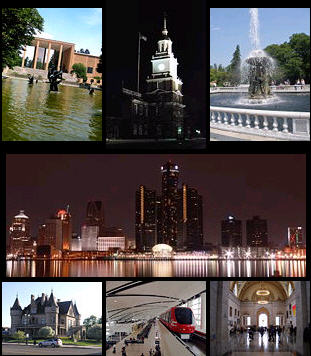The music of Michigan is composed of many different genres. The city of Detroit has been one of the most musically influential and innovative cities for the past 50 years, whether in Michigan or anywhere else in the United States. Impressively, for 48 straight years (1959–2007) a greater Michigan-area artist has produced a chart-topping recording. Michigan is perhaps best known for three developments: early punk rock, Motown, and techno.

Metro Detroit is a major metropolitan area in the U.S. state of Michigan, consisting of the city of Detroit and over 200 municipalities in the surrounding area. There are varied definitions of the area, including the official statistical areas designated by the Office of Management and Budget, a federal agency of the United States.

The Detroit Opera House is an ornate opera house located at 1526 Broadway Street in Downtown Detroit, Michigan, within the Grand Circus Park Historic District. The 2,700-seat venue is the home of productions of the Detroit Opera and a variety of other events. The theatre was originally designed by C. Howard Crane, who created other prominent theatres in Detroit including The Fillmore Detroit, the Fox Theater and the Detroit Symphony's Orchestra Hall. It opened on January 22, 1922.

Southeast Michigan, also called southeastern Michigan, is a region in the Lower Peninsula of Michigan that is home to a majority of the state's businesses and industries as well as slightly over half of the state's population, most of whom are concentrated in Metro Detroit.

The University of Michigan School of Music, Theatre & Dance is an undergraduate and graduate institution for the performing arts in the United States. It is part of the University of Michigan at Ann Arbor. The school was founded in 1880 after Henry Simmons Frieze, founder and president of the Choral Union and the University Musical Society, urged leaders to include music among the school's offerings. The college was known then as the Ann Arbor School of Music. It was later incorporated into the University of Michigan with Calvin Brainerd Cady joining the faculty as the first instructor in music, after already being hired by Frieze to conduct the Choral Union.
The culture of Ann Arbor, Michigan includes various attractions and events, many of which are connected with the University of Michigan.

Lake Algonquin was a prehistoric proglacial lake that existed in east-central North America at the time of the last ice age. Parts of the former lake are now Lake Huron, Georgian Bay, Lake Superior, Lake Michigan, Lake Nipigon, and Lake Nipissing.
Alden B. Dow was an American architect based in Midland, Michigan, and known for his contributions to the style of Michigan Modern. During a career that spanned from the 1930s to the 1960s, he designed more than 70 residences and dozens of churches, schools, civic and art centers, and commercial buildings. His personal residence, the Midland Center for the Arts, and the 1950s Grace A. Dow Memorial Library are among numerous examples of his work located in his hometown of Midland, Michigan. The son of Herbert Henry Dow and philanthropist Grace A. Dow, Dow is known for his prolific architectural designs.

Tourism in metropolitan Detroit, Michigan is a significant factor for the region's culture and for its economy, comprising nine percent of the area's two million jobs. About 15.9 million people visit Metro Detroit annually, spending an estimated $4.8 billion. Detroit is one of the largest American cities and metropolitan regions to offer casino resort hotels. Leading multi-day events throughout Metro Detroit draw crowds of hundreds of thousands to over three million people. More than fifteen million people cross the highly traveled nexus of the Ambassador Bridge and the Detroit-Windsor Tunnel annually. Detroit is at the center of an emerging Great Lakes Megalopolis. An estimated 46 million people live within a 300-mile (480 km) radius of Metro Detroit.

The roads and freeways in metropolitan Detroit comprise the main thoroughfares in the region. The freeways consist of an advanced network of interconnecting freeways which include Interstate highways. The Metro Detroit region's extensive toll-free freeway system, together with its status as a major port city, provide advantages to its location as a global business center. There are no toll roads in Michigan.

The following outline provides an overview of and topical guide to the U.S. state of Michigan:
The performing arts in Detroit include orchestra, live music, and theater, with more than a dozen performing arts venues. The stages and old time film palaces are generally located along Woodward Avenue, the city's central thoroughfare, in the Downtown, Midtown, and New Center areas. Some additional venues are located in neighborhood areas of the city. Many of the city's significant historic theaters have been revitalized.








